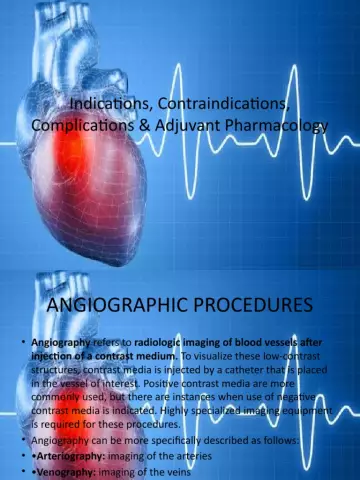- Author Curtis Blomfield [email protected].
- Public 2023-12-16 20:44.
- Last modified 2025-01-23 17:01.
Ultraviolet blood irradiation refers to methods of extracorporeal detoxification. It is also called photohemotherapy or is abbreviated as UVI blood. It is a dosed exposure of blood to ultraviolet rays.
Irradiation of the human body with ultraviolet light has been used for a long time. In clinical practice, blood ultraviolet irradiation techniques are used for various skin, surgical infections and other diseases.
The main problem of this method is the insufficient clinical study of ultraviolet effects on the human body. The popularity and prevalence of the method is based solely on the experience of its application.

UV irradiation has the following therapeutic effects:
- bactericidal (antiseptic) action;
- anti-inflammatory effect;
- correction of humoral and cellular immunity;
- acceleration of tissue regeneration (healing);
- vasodilating action;
- improvement of the acid-base state of the blood;
- erythropoiesis (stimulation of the formation of red blood cells);
- desensitizing (antiallergic) action;
- normalization of antioxidant and proteolytic activity of blood;
- detoxification action.
Methods for conducting UVI blood
There are two ways of blood irradiation - extravascular and intravascular.

Photohemotherapy is carried out in a specially equipped room, close to the surgical box (operating room) on demand. The patient is placed on the couch in the supine position. Needle puncture the vein of the upper limb. Intravascular irradiation is carried out by introducing a light guide into the vessel through the cavity of the needle. Extracorporeal, i.e. extravascular irradiation occurs by passing pre-taken blood through a quartz cuvette with heparin. After the blood is irradiated, it returns back to the bloodstream. The session lasts 45-55 minutes. To achieve a therapeutic effect, 6-10 courses of UV blood are prescribed.
Before the UV blood session
The patient does not need special preparation. It is only necessary to do a general blood test and, in some cases, a biochemical, coagulogram (blood clotting condition). On the day of the procedure, you need a good diet with enough sweets before the procedure, as well as after it and throughout the day.
Indications for photohemotherapy:
- poisoning and purification of blood from alcohol;
- inflammatory processes of various genesis and localization;
- thrombophlebitis;
- autoimmune diseases;
- septic conditions;
- postoperative infections;
- bronchial asthma;
- pancreatitis;
- skin diseases: acne, furunculosis, psoriasis, dermatoses of various origins;
- diabetes mellitus;
- trophic skin ulcers;
- polycystic ovaries;
- viral hepatitis;
- herpes;
- burns;
- gastric ulcer;
- ENT diseases;
- diseases of the urinary system: pyelonephritis, cystitis, urethritis;
Contraindications:
- violation of the blood coagulation system;
- prolonged bleeding;
- ischemic or hemorrhagic stroke;
- increased sensitivity to solar radiation;
- malignant neoplasms;

- epilepsy;
- active tuberculosis, AIDS (HIV).
Possible Complications
If the procedure is carried out according to the recommendations, then there should be no serious complications. In rare cases, photoallergic reactions have been observed.
There is no age limit for UVI blood. Reviews of patients who underwent an irradiation session are ambiguous. Some report an improvement in well-being, while others do not see a significant effect for them.






